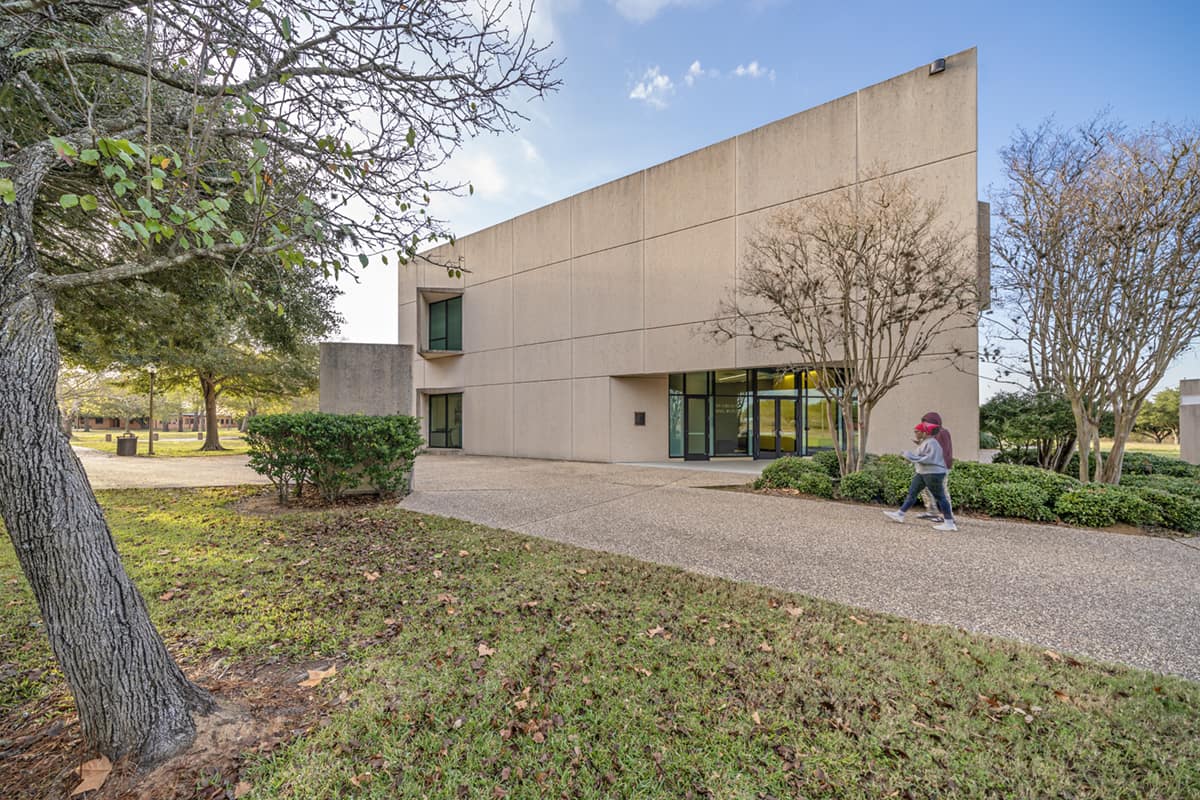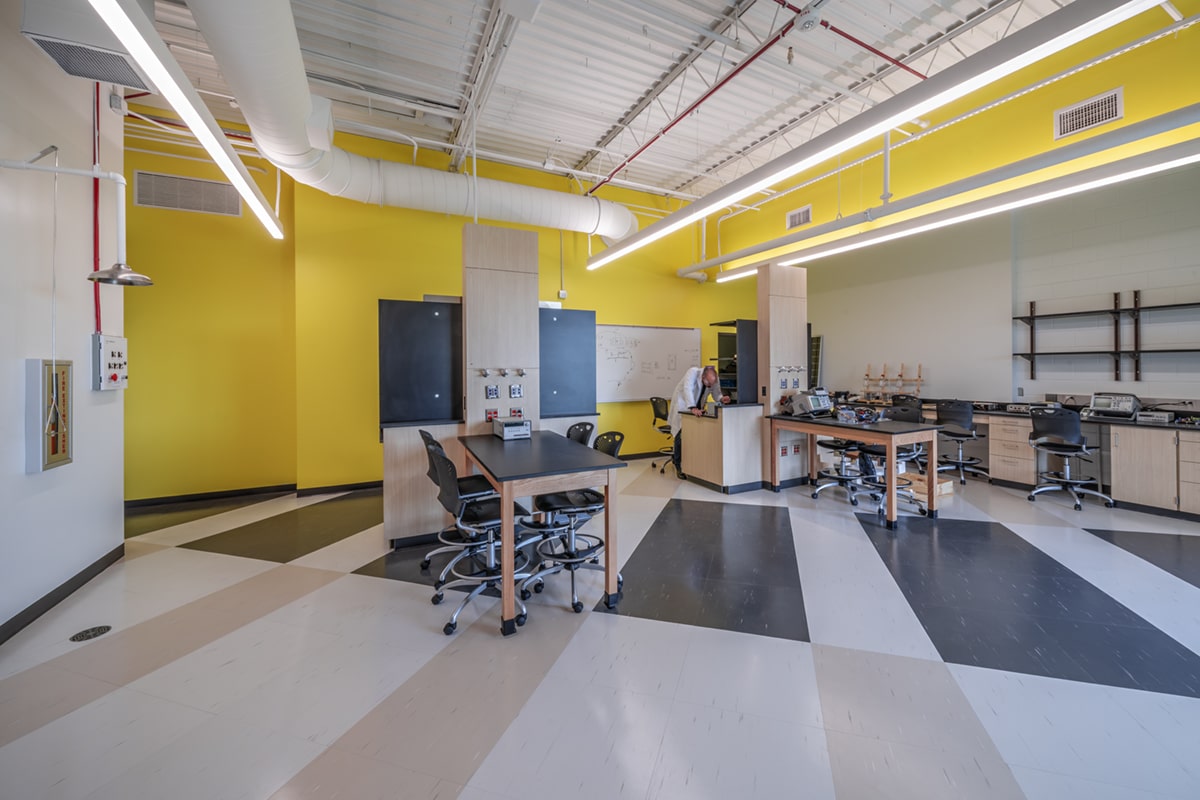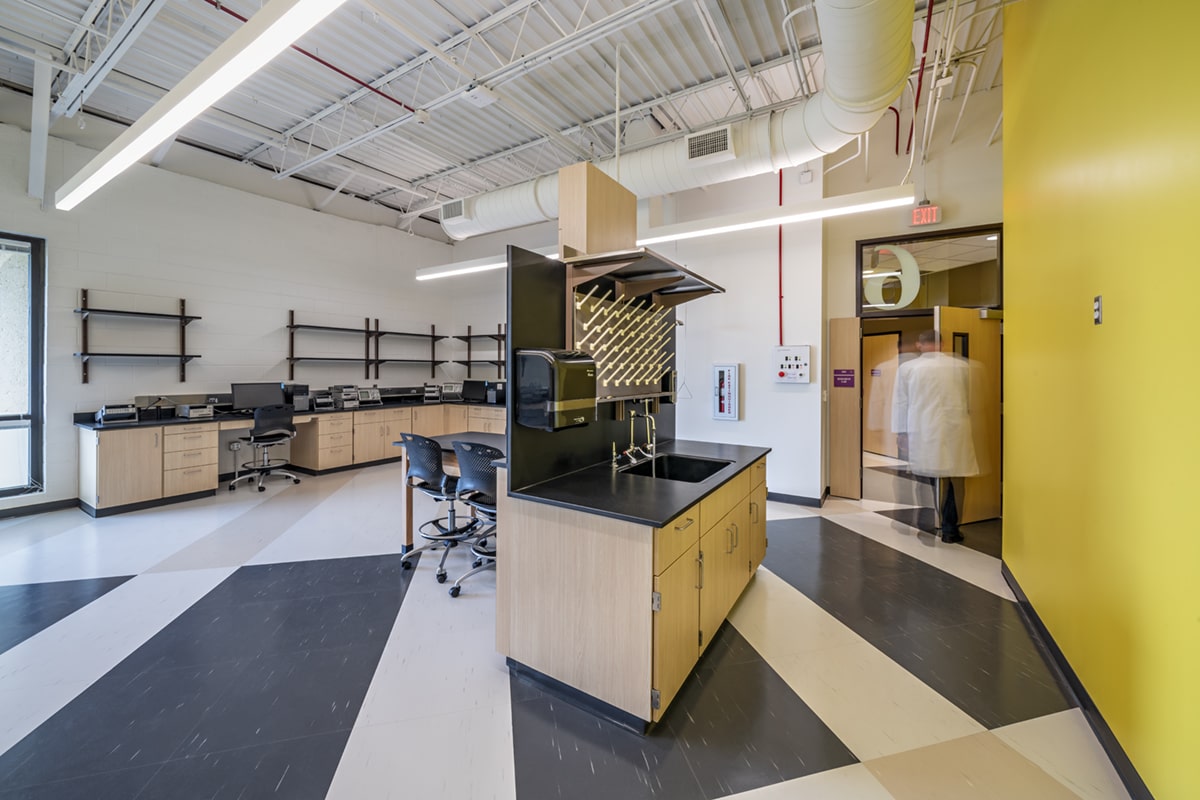When it comes to higher education lab design, new trends and needs are constantly changing the way universities and architects think about collaborative research environments. At the same time, colleges facing tight budgets many times must forgo new construction for renovating older buildings. Prairie View A&M University faced this choice in refreshing its Austin Greaux Engineering Building.
While friendlier on the wallet, renovating and repurposing older facilities – especially for lab spaces – can prove to be a challenge for universities. Austin Greaux started out in 1987 as a Brutalist-design chemical engineering teaching facility. Abandoned over five years ago, the 12,000-square foot building was riddled with mold and asbestos, and designing around old infrastructure meant the architects had to focus on bringing everything up to code.

Main entry at the Quad. Preserving the original concrete Brutalist exterior, work included high performance glazing systems and insulated envelope.
(Tip: For renovations, the client needs to do a hazardous materials abatement survey early in the project design to limit surprises. If the building is vacant, have the abatement done during the design)
Walls, doors – even non-code-compliant stairways – were knocked down, and the whole building was gutted. By the end of construction, a modern incubator research laboratory stood proudly in the place of the once brooding structure.
Even with a tight budget, GSR Andrade Architects set out to design a space that was adaptable to future needs without compromising on a crisp, clean aesthetic to stimulate researchers and faculty. The goals of the project were to inspire creativity, promote physical and social health, and create a natural, relaxing atmosphere with an abundance of light and comfort.
According to a 2019 article by Formaspace, the trends are as follows:
GSR Andrade succeeded in applying elements from these to make the best possible outcome for the university renovation.
Team-based science practices are ideal, especially in research environments on a college campus. They require ample open space and room to move around one another without compromising an experiment or study. By simplifying labs back to the basics, GSR Andrade maximized the square footage and designed a smooth flow conducive to group-based activities. It also featured interconnected lab and office spaces to encourage easy flow of traffic and collaborative energy.
Austin Greaux’s communal areas, such as meeting and dining areas, and an inviting lobby, promote a social atmosphere. A 2011 study on social relationships and health by Debra Umberson and Jennifer Karas Montez establishes that people who are more socially connected are healthier and live longer than their more isolated peers. Now more than ever, mental health is being taken very seriously in higher education. College is not just about pulling lonely all-nighters anymore—it is about promoting healthy habits with spaces to nurture young minds.
Interior design and systems/envelope upgrades enable the facility to redefine grant-based research for the next generation by delivering highly adaptive, interdisciplinary lab environments. Mobile, modular furniture and built-in “umbilical” units, coordinated with lab equipment manufacturer Mott Manufacturing, allow for flexible open floor space.
Incubator Lab. Natural daylighting, exposed structure/utilities, linear lighting, flexible casework, color and supergraphics activate the technology-rich interior.

Many researchers value aesthetic workspaces for the same reason they are designed: beautiful spaces make people happy and engaged. GSR Andrade capitalized on the power of interior design and natural lighting. Countering the heavy institutional feel of the existing concrete building shell, the design incorporates bold warm color to activate the laboratories, stairways, and lobbies. Lab utilities and services are exposed for an open industrial aesthetic. At the lobby, integrated ceiling and linear lighting establish the technology-rich building interior.
The spaces are all symmetrically arranged, an organizational approach for ease of wayfinding that resonates with human nature. Daylighting is drawn inside to maximize limited existing openings and promote wellness. According to the Journal of Circadian Rhythms in 2018, three Swedish scientists studied bright daylight exposure and consequential moods of workers. Results revealed workers exposed to more natural light are happier and calmer than others that receive limited exposure. It is thought that sunlight triggers a release of serotonin within the brain, which may explain this correlation. Moreover, more natural light increases the facility’s energy efficiency by reducing the need for artificial lighting.

Incubator Lab. Natural daylighting, exposed structure/utilities, linear lighting, flexible casework, color and supergraphics activate the technology-rich interior.
When it comes to sustainability, many traditional laboratories can lag—they can use five times more energy than standard office buildings. Researchers rely more heavily on technology and high-energy equipment. This called for a major reassessment of sustainability practices, which was one of GSR Andrade’s priorities when the firm approached the project. Energy consumption and HVAC load were reduced through enhanced wall and roof insulation, as well as replacement of all glazing with insulated glass.
This year, the Austin Greaux Engineering Building renovation was recognized for outstanding laboratory design in American School & University Magazine. The project was made possible under the Texas A&M University System’s Chancellor’s Research Initiative. Overall, the lab’s design supports researcher expectations for dynamic, real-world scenarios and fosters pride of ownership. Thirty-five years after the building’s construction, the upgrades respect and honor the past, yet embrace the evolution of contemporary laboratory needs.